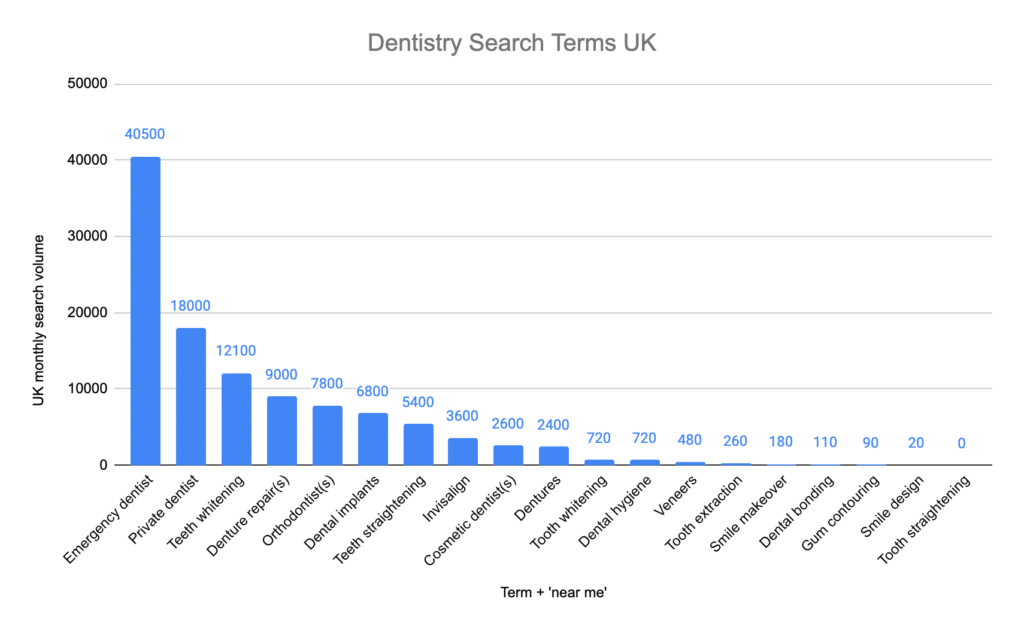Dentists offer many services, but which ones are people really searching for, and how should you optimise your site to best reach people making those searches? In this post we’ll look at the latest SEO data for dental clinics, and how to optimise your site for them.
Optimising for ‘Dentist’
The graph below shows relative search volumes for different dental niches, but let’s start simple. Make sure your site is optimised for dentist and your location(s) first and foremost. For all healthcare industries, the core service always gets vastly more searches than the niche searches.
The term ‘dentist’ doesn’t appear on the graph below because it eclipses all the other terms, with ‘dentist near me’ getting 210,000 searches a month, double all the other searches together.
When picking your location, don’t go too wide or small. If you’re in a town of let’s say 3,000 – 300,000 people, people will tend to search for the town name, e.g. ‘dentist wrexham’ or ‘dentist southend’. When you get bigger – say London or Manchester, people are more likely to search for a region within that area, such as a borough, or just ‘near me’.
Niche Dentistry Search Terms
The graph below shows niche dentistry and cosmetic dentistry search terms in the UK:

This data first of all informs us as to the services that are worth optimising for. Look at the services you provide – or want to provide – and focus on optimising for the highest search volume. For cosmetic dentists this might be teeth whitening, dental implants, teeth straightening, Invisalign, and so forth. There are other factors – what are your competitors doing, what do you make most money on, etc., which will help you choose your optimisations. Search volume is only one factor in the equation, but it’s a very important one.
How to Optimise for Key Terms using Treatment Pages
To begin hitting our niche terms seriously we need a page for each service. This allows us to optimise a page entirely for that search term and our location – for example ‘ teeth whitening bromley’. When someone makes this or a similar service + location search, the fact we have a page dedicated and optimised entirely to that and nothing else allows Google to return it higher as the page most relevant to the search (as opposed to a page about several different services).
Create a services sub-menu on your site with a page for each service you want to offer, focusing first on the highest-volume searches.
Whereas your homepage – for example – should be focused enough to just get key marketing information across, your service pages should be stacked with content: explanations, photos, videos, FAQs, prices – as much as possible to make this page a more useful resource to the person making the search than that of other clinics. Aim for 1000 words plus as much rich content (photos, videos etc.) as you can.
Also include an embedded Google map(s) and link to your location page(s) to give more geographical relevance and allow Google to confidently return your pages to people in your area making that search.
Where possible and without linking to competitors, link to other high-authority resources about the service you are providing. That might be to websites like the NHS, BUPA and so on, or anything that might add value to the person wanting to find out more.

Videos – whether yours or embedded from YouTube – are particularly good as they increase page engagement time. Google will judge a lot on how long people tend to stay on a page, as it’s a more reliable metric of how useful a page is than any algorithm.
Include links to your clinician pages so users can ‘meet’ the dentists who provide the service, and also add a ‘medical review’ section linking back to the clinician page who wrote or reviewed the content for accuracy. This is crucial for EEAT.
Using Treatment Pages as Pillar Content
Once your treatment pages are created, you can continue making them more useful with blog posts that link back to them. Your blog posts should be more specific and niche. So where your Invisalign page talks about Invisalign, before / after, some FAQs, videos etc., you might then create a blog post called ‘The Invisalign Process’ or a longer testimonial ‘My Invisalign Experience’ and so on, drilling down into a particular angle.
When creating blog posts, think about how you can also repurpose this content as well as just reinforcing your pillar content (i.e. your treatment page). Can you get a link to it from somewhere else, can you share it on new social media groups, is it interesting for local media, etc. We want to maximise the potential use and reach of any content we create, not just churn out content in a vacuum.
Other Considerations
Having a website full of great and well-optimised content is only one side of the SEO coin. Authority is the other. To do SEO successfully you also need to build inbound links to your site and get people talking about you. But it starts with a great and well-optimised website full of content.
Can We Help?
I hope you found this post useful. If you’d like to know more about marketing your clinic online via your website, SEO, Google Ads and social media, book a call with me to talk about your strategy, and how we might be able to help you.
